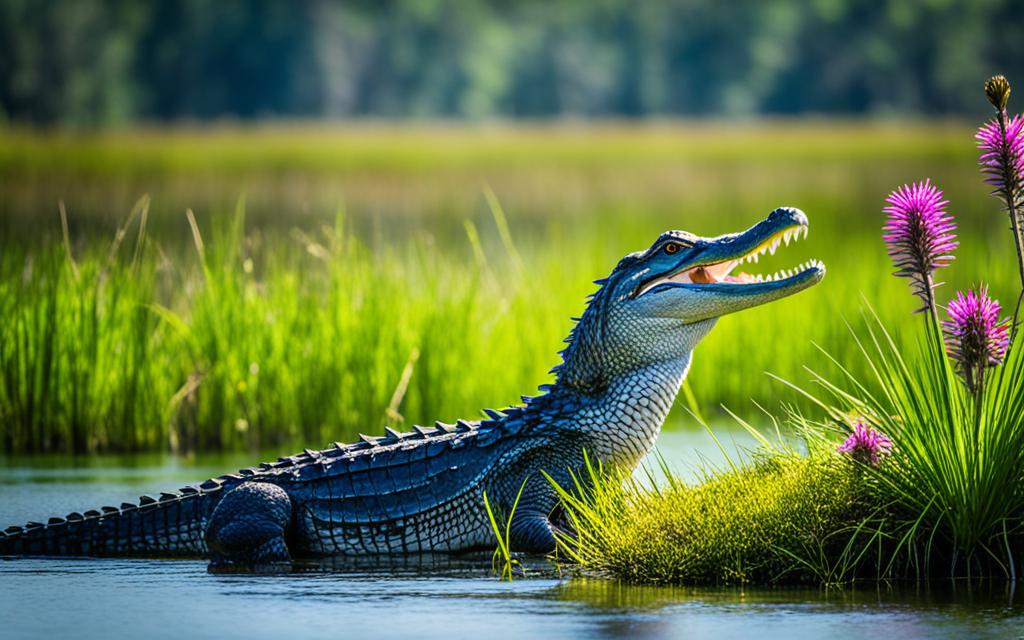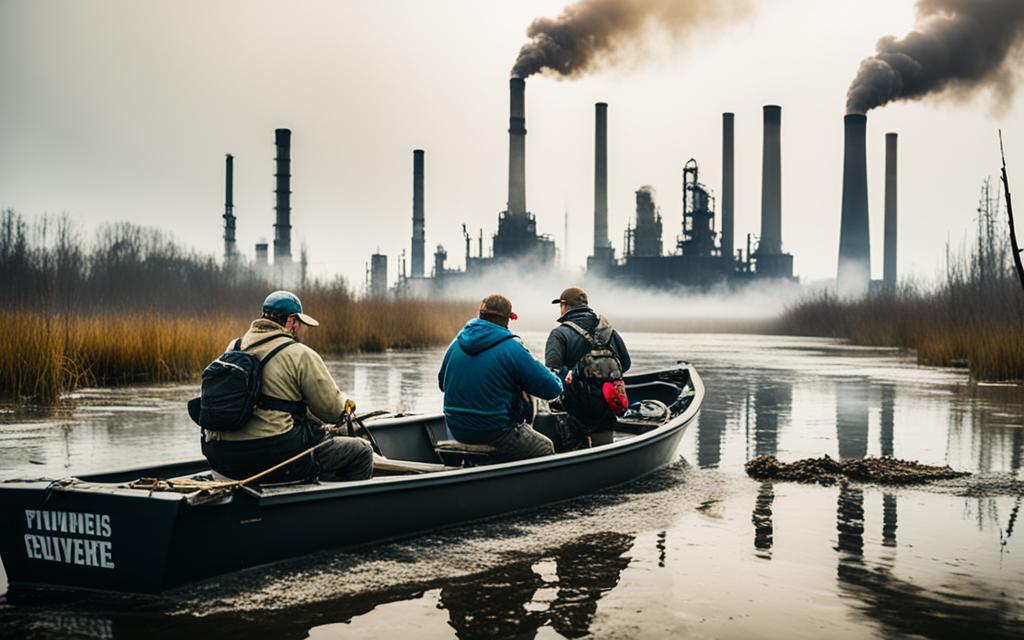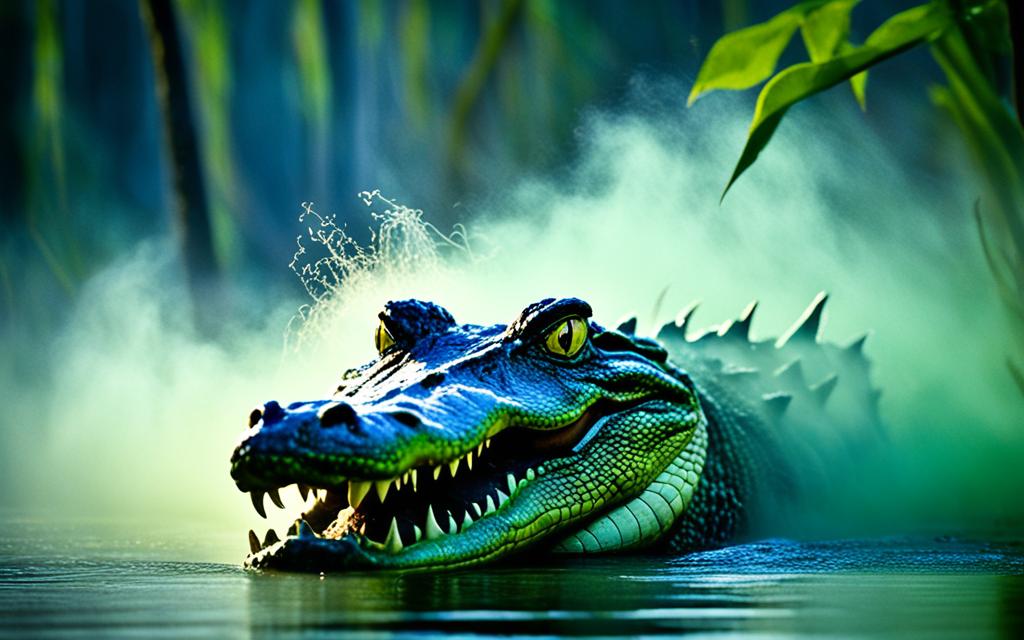The Florida Everglades, known as Gatorcountry, are famous for their diverse ecosystems. They are home to a fascinating phenomenon called swamp gas. This gas is often seen by visitors, adding mystery and beauty to the vast wetlands.
Swamp gas comes from the complex wetlands and offers a special experience for everyone. Its mysterious nature shows how dynamic and changing the Florida Everglades are. Whether you’re walking through the mangroves or on a boat tour, seeing swamp gas is a key part of visiting Gatorcountry.
The Formation of Swamp Gas in Florida’s Everglades
Swamp gas is a fascinating phenomenon found in Florida’s Everglades. This vast wetland spans 1.5 million acres, making it perfect for swamp gas formation. It’s full of plants and animals, and its complex wetland ecosystems help create this gas. This gas, also called “marsh gas,” comes from the natural decay of organic matter in low-oxygen areas typical of marshlands. Let’s explore how swamp gas forms in these unique environments.
What is Swamp Gas?
Swamp gas is mostly methane, a colorless and odorless gas found in wetlands. It forms when microorganisms break down organic material without oxygen. In the Everglades, hunters and researchers see bubble trails in the water, which means methane is being released. These trails help track alligators and other wildlife.
The Role of Wetland Ecosystems
Wetlands like the Everglades are key for swamp gas formation. They’re full of life, which means lots of organic decay. Hunters notice that alligators move more in cold, dry winters. This movement can disturb the sediment, letting more methane out.
The many plants in these areas also affect gas production. They provide a steady supply of organic material for decomposition.
Natural Decomposition Process
The natural process of decomposition is key to swamp gas production. As plants and other organic stuff decay, microbes turn them into gases like methane and carbon dioxide. This natural decomposition is vital for the ecosystem.
Larger alligators help by stirring up the sediment, speeding up decomposition. The Everglades are home to many species and are a hotspot for biochemical activity. This creates a lot of swamp gas.
Flamingo Adventures in the Everglades shows off these wetland processes. Visitors can enjoy canoeing, kayaking, and boating at the Flamingo Marina. Learning about natural decomposition and wetland ecosystems helps us appreciate nature’s balance in the Everglades.
The Environmental Impact of Swamp Gas Emissions
Swamp gas emissions, mainly methane, have a big effect on the environment. This gas is a strong greenhouse gas that helps cause global warming and climate change. Wetlands like the Florida Everglades see more of this gas, making things worse.
Greenhouse Gases and Global Warming
Greenhouse gases like methane trap heat in our atmosphere, leading to global warming. This makes temperatures go up and changes the weather. Wetlands are now key areas for studying how climate change works.
The Impact on Local Climates
In the Everglades, swamp gas emissions change the local climate and ecosystems. These changes affect how animals and plants live. Scientists have seen changes in where animals migrate, when they have babies, and how many there are.
Knowing about these changes is key to saving these areas. It helps us make plans to protect them.
Gatorcountry Swamp Gas and Methane Emissions
The Gatorcountry swamp gas is key when talking about methane emissions and climate change. It’s mostly methane, which warms the planet more than carbon dioxide. Scientists are studying the Everglades to understand how much methane it releases and its effect on the climate.
Researchers are looking into the makeup and amount of Gatorcountry swamp gas. They want to know how it affects climate change. Methane from swamps like these adds to the greenhouse gases that make global warming worse. Knowing about these emissions helps us find ways to reduce them.
Let’s look at how methane and carbon dioxide compare in terms of global warming potential over 20 years:
| Gas Type | Global Warming Potential (GWP) over 20 years | Sources |
|---|---|---|
| Methane | 84-87 times | Swamp gas, agricultural practices, leakage from natural gas systems |
| Carbon Dioxide | 1 time | Burning fossil fuels, deforestation |
This table shows how methane emissions, like those from Gatorcountry swamp gas, can greatly affect our climate. By understanding these emissions, we can tackle climate change better.
Flora and Fauna of the Everglades
The Everglades is full of diverse plant and animal life. This ecosystem is balanced by the interaction between plants and animals. Every part, from the bayou wildlife to the swamp gas plants, is crucial.
Bayou Wildlife Interaction
In the Everglades, you’ll find alligators, turtles, birds, and fish. These animals thrive in the wetlands and work closely with the plants. Alligators are a key species, with a big population that has grown since the 1980s.
Florida makes almost $2 million a year from alligator hunting. This money helps protect the bayou wildlife. In 2015, alligator farms made $6.8 million from hides and $1.7 million from meat.
Gator eggs and skins are valuable, with prices over $60 and $40 per foot. Florida issues 6,000 hunting permits a year. This helps manage the alligator population in a sustainable way.

Plants Contributing to Swamp Gas
Some plants in the Everglades make swamp gas by decomposing naturally. These plants, like sawgrass and cypress trees, support many animals. They help keep the wetlands healthy.
These plants also help with carbon sequestration. Their roots hold the soil in place and filter the water. This creates a home for many species. The balance between plants and animals is key to the Everglades’ survival.
Ecological Significance of Swamp Gas in Wetland Ecosystems
The Everglades in Florida are full of life, showing how important swamp gas is. Swamp gas affects local climates and is key in climate change studies.
Importance to Climate Change Studies
Swamp gas, mostly methane, adds to greenhouse gases. This makes it vital for climate change studies. By studying swamp gas, scientists can improve climate models and forecasts. This helps in fighting global warming.
Conservation Efforts
Protecting wetlands is key to managing swamp gas and its effects. Diverse plants and animals keep the Everglades ecosystem balanced. The Everglades National Park is home to 200,000 alligators, showing the area’s biodiversity.
Theme parks like Gatorland also help by caring for alligators. They teach people why these ecosystems are important.
| Location | Alligator Population | Conservation Contribution |
|---|---|---|
| Everglades National Park | 200,000 | Provides natural habitat and research opportunities for swamp gas and climate change studies |
| Gatorland | Thousands | Educates the public and supports the conservation of rare white alligators with leucistic traits |
By understanding and managing swamp gas, we can reduce risks and use it for climate resilience and science.
Human Activities and Their Influence on Swamp Gas Production
Human actions in the Everglades have greatly changed the ecosystem. This includes how swamp gas production works. Understanding these changes is key to fixing their effects.

- Building on land takes away areas where swamp gas is made.
- Changing how water is managed can stop the natural process of making swamp gas.
- Pollution from farms and factories adds chemicals that change wetland processes.
These actions change how much swamp gas is made and affect the ecosystem. Let’s look at the big effects of human actions:
| Activity | Impact on Swamp Gas Production | Ecosystem Impact |
|---|---|---|
| Urbanization | Decreases wetland area and alters gas production cycles | Loss of habitat, increased pollution |
| Agriculture | Introduces fertilizers and chemicals affecting microbial activity | Water contamination, reduced biodiversity |
| Industrial activities | Contributes to chemical runoff impacting gas production | Disrupted ecosystems, wildlife displacement |
“Future research and responsible environmental stewardship are essential to understanding and mitigating human impacts on swamp gas production in the Everglades.”
By studying how human actions and swamp gas production are linked, scientists can guess the future effects on the ecosystem. This helps in making better plans for conservation.
Future of Swamp Gas Research and Environmental Conservation
The future of swamp gas research is bright for protecting the environment, especially wetlands. Scientists are diving deep into Florida’s Everglades to learn more. They aim to find ways to fight global climate change. By understanding swamp gas better, we can protect this natural treasure for the future.
Recent studies have made big discoveries. “Gator Country: Deception, Danger, and Alligators in the Everglades” shows how hard it is to balance conservation with human needs. The story of Operation Alligator Thief, where a fake alligator farm caught poachers, highlights this challenge. Alligators are crucial for keeping the ecosystem healthy and diverse.
Public awareness is key to success. Studies show that even funny memes about alligators can help people care more about conservation. Seeing alligators as important species emphasizes their role in nature. As we learn more, more people will support swamp gas research and protecting the environment. This will help keep these wetlands safe for the future.
Source Links
- https://southernairboat.com/community/threads/duck-hunting-and-dogs-in-fl.5987/
- https://www.boatus.com/expert-advice/expert-advice-archive/2022/september/escape-to-the-everglades
- https://www.bigthicket.org/img/btabulletin159.pdf
- https://www.loc.gov/nls/new-materials/talking-book-topics/talking-book-topics-july-august-2024/
- https://www.miaminewtimes.com/news/the-dark-side-of-floridas-booming-alligator-industry-9502790
- https://fastercapital.com/content/Gator-Sightings–Exploring-Tourist-Hotspots-for-Wildlife-Enthusiasts.html
- http://ufdcimages.uflib.ufl.edu/UF/00/02/82/90/01674/02-21-2013.pdf
- https://www.bookpage.com/genres/environment/
- https://blog.librarything.com/page/2/

